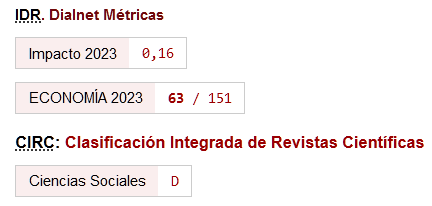Equitable and sustainable territorial development: territorially particularized discount rates in the evaluation of infrastructure projects with intergenerational effects.
DOI:
https://doi.org/10.46661/rec.10193Keywords:
suatainability, intergenerational equity, balanced development, discount rate, public investmentsAbstract
This paper studies possibilities for achieving equitable and sustainable territorial development, according to the statement of the Brundtland Principle of Sustainable Development (PDS-B), in the materialization of real investment projects with long-term environmental effects that affect future generations, as is the case with infrastructure projects. To achieve this objective, new concepts applicable to the economic analysis of these projects are established and, through macroeconomic indicators, environmental discount rates are set for various countries grouped according to the wealth degree established by the World Bank. The discount rates obtained are compared with other rates proposed for some countries. Finally, the work done is commented, showing characteristics, critical points, restrictions in its application and aspects susceptible to complementary investigations.
Downloads
References
Almansa, C. y Calatrava, J. (2007a): "La problemática del descuento en la evaluación económica de proyectos con impacto intergeneracional: tasa ambiental crítica y montante de transferencia intergeneracional", Revista de Estudios de Economía Aplicada, Vol. 25, pp.165-197.
Almansa, C. y Calatrava, J. (2007b): "Reconciling sustainability and discounting in Cost-Benefit Analysis: A methodological proposal", Ecological Economics, Volume 60, Issue 4, pp. 712-725.
https://doi.org/10.1016/j.ecolecon.2006.05.002 DOI: https://doi.org/10.1016/j.ecolecon.2006.05.002
Azqueta, D. (1994): Valoración Económica de la Calidad Ambiental, Ed. Mc-Graw Hill / Interamericana. Madrid.
Azqueta, D. (2002): Introducción a la economía ambiental, Ed Mc-Graw Hill. Madrid.
Banco Mundial (2016): "Indicadores del Banco Mundial".
Barro, R. (1990): "Government Spending in a Simple Model of Endogenous Growth", Journal of Political Economy, 98, (5), II, pp. 103-125.
https://doi.org/10.1086/261726 DOI: https://doi.org/10.1086/261726
Baum, S.D. (2009): "Description, Prescription and the Choice of Discount Rates", Ecological Economics, 69, pp.197-205.
https://doi.org/10.1016/j.ecolecon.2009.08.024 DOI: https://doi.org/10.1016/j.ecolecon.2009.08.024
Baumol, W.J. (1968): "On the social rate of discount", American Economic Review, 58(4), pp.: 788-802.
Becker, G. (1963): "Investment in human capital: a theorical analysis". Journal of Political Economy, Oct. 1962, pp. 9-49.
https://doi.org/10.1086/258724 DOI: https://doi.org/10.1086/258724
Bosworth, B. y Collins, S. M. (2003): "The empirics of growth: An update", Brookings papers on economic activity, vol. (2), pp.113-206.
https://doi.org/10.1353/eca.2004.0002 DOI: https://doi.org/10.1353/eca.2004.0002
Campos, J. y Serebrisky, T. (2015): "Porque el tiempo pasa: evolución teórica y práctica de la tasa social de descuento". Banco Interamericano de Desarrollo; Sector de Infraestructura y Medio Ambiente; Nota Técnica Nº IDB-TN-8.
https://doi.org/10.18235/0000137 DOI: https://doi.org/10.18235/0000137
Campos, J., Serebrisky, T. y Suárez-Alemán, A. (2016): "Tasa social de descuento y evaluación de proyectos: algunas reflexiones para America Latina y del Caribe". Banco Interamericano de Desarrollo; Sector de Infraestructura y Medio Ambiente; Monografía 413.
https://doi.org/10.18235/0000244 DOI: https://doi.org/10.18235/0000244
Comité de Desarrollo Territorial de la Unión Europea (1999): Estrategia Territorial Europea, pp. 9-12, pp. 38-49 y pp. 57-68.
Costanza, R., Daly, H.E. (1992): "Natural Capital and Sustainable Development". Conservation Biology. Vol. 6. No.1, pp. 37-46.
https://doi.org/10.1046/j.1523-1739.1992.610037.x DOI: https://doi.org/10.1046/j.1523-1739.1992.610037.x
Costanza, R., d'Arge, R., de Groot, R., Farber, S., Grasso, M., Hannon, B. et al. (1997): "The value of the world's ecosystem services and natural capital". Nature, 387, pp. 253-260.
https://doi.org/10.1038/387253a0 DOI: https://doi.org/10.1038/387253a0
Cropper, M., Aydede, S.K. y Portney, P.R. (1991): "Discounting Human Lives". American Journal of Agricultural Economics. 73, pp.: 1410-1415.
https://doi.org/10.2307/1242393 DOI: https://doi.org/10.2307/1242393
Cropper M. y Laibson, D. (1999): "The implications of hyperbolic discounting for project evaluation" in Discounting and Intergenerational Equity, Resources for the Future. Portney y Weyant (Eds.), Washington.
Daly, H.E. (1990): "Toward some operational principles of sustainable development". Ecological Economics, Vol. 2 (1), pp. 1-6.
https://doi.org/10.1016/0921-8009(90)90010-R DOI: https://doi.org/10.1016/0921-8009(90)90010-R
Delgado, M.J. y Álvarez, I. (2001): "Metodología para la elaboración de índices de equipamiento de infraestructuras productivas". Momento Económico, No. 117, pp.: 20-34.
Díaz, C. y Martinez, D. (2006): "Inversión pública y crecimiento: un panorama". Revista de Economía Pública de Hacienda Pública Española: 176-(1/2006), pp. 109-140.
Edwards, G (2014): "Estimación de la tasa social de descuento en el largo plazo en el marco del sistema nacional de inversiones". Trabajo realizado para la División de Evaluación de Inversiones. Ministerio de Desarrollo Social de Chile.
Eberle, W.D. y Hayden, F. G. (1991): "Critique of Contingent Valuation and Travel Cost Methods for Valuing Natural Resources and Ecosystems". Economics Department Faculty Publications, University of Nebraska, 13.
https://doi.org/10.1080/00213624.1991.11505196 DOI: https://doi.org/10.1080/00213624.1991.11505196
Florio, M., Finzi, V., Genco, M., Levarlet, F., Maffi, S., Tracogna, A. y Vignetti, S. (2003): "Guía del análisis costes/beneficios de los proyectos de inversión" Capitulo No. 2. Memorando destinado al redactor de proyectos. Editorial: Dirección General de Política Regional de la Unión Europea.
Fontela, E. y Rojo, T. (1991): "Infraestructuras, desarrollo regional y ecología humana", Revista de Estudios Regionales, No 30: 15-26.
Freeman, A.M. (1993): "The measurement of environmental and resource values: Theory and methods". Ed. Resources for the Future. Washington DC.
Giménez, G. y Sanau, J. (2007): "Interrelationship among institutional infrastructure, technological innovation and growth. An empirical evidence". Journal of Applied Economics. 39 (10), pp. 1267-1282.
https://doi.org/10.1080/00036840500438988 DOI: https://doi.org/10.1080/00036840500438988
Gintis, H. (2000): "Beyond homo economicus: evidence from experimental economics". Ecological Economics, 35: 311-322.
https://doi.org/10.1016/S0921-8009(00)00216-0 DOI: https://doi.org/10.1016/S0921-8009(00)00216-0
Harberger, A.C. (1984): "Basic needs versus distributional weights in social cost-benefit analysis". Economic Development and Cultural Change, Vol 32, No. 3. pp. 455-474.
https://doi.org/10.1086/451400 DOI: https://doi.org/10.1086/451400
Harvey, C.M. (1994): "The reasonableness of non-Constan discounting". Journal of Public Economics, No 53, pp.: 31-51.
https://doi.org/10.1016/0047-2727(94)90012-4 DOI: https://doi.org/10.1016/0047-2727(94)90012-4
Hicks, J. (1973): "Capital y Tiempo", Méjico D.F.: Fondo de Cultura Económica, S.L., pp. 23-45 y pp. 132-190.
Hueting, R. (1987): "Economic Aspects of Environmental Accounting". Journal of Interdisciplinary Economics 2(1), pp. 55-71.
https://doi.org/10.1177/02601079X8700200105 DOI: https://doi.org/10.1177/02601079X8700200105
Loewenstein, G.F. y Prelec, D. (1992): "Anomalies in intertemporal choice: evidence and interpretation". Quarterly Journal of Economics, 107 (2), pp. 573-597.
https://doi.org/10.2307/2118482 DOI: https://doi.org/10.2307/2118482
López-Pueyo, C., Barcenilla, S., y Giménez, G. (2018): "The two faces of human capital and their effect on technological progress". Panoeconomicus. Vol. 65, n. 2, pp. 163-181.
https://doi.org/10.2298/PAN151002014L DOI: https://doi.org/10.2298/PAN151002014L
Lucas, R. (1988): "On the mechanics of development planning", Journal of Monetary Economics, Vol 22, Issue 1, pp. 3-42.
https://doi.org/10.1016/0304-3932(88)90168-7 DOI: https://doi.org/10.1016/0304-3932(88)90168-7
Luckert, M., Admowicz, W. (1993): "Empirical measures of factors affecting social rates of discount". Environmental and Resource Economics, 3, pp. 1-21
https://doi.org/10.1007/BF00338317 DOI: https://doi.org/10.1007/BF00338317
Lumeley, S. (1997): "The environment and the ethics of discounting: An empirical analysis". Ecological Economics 20: 71-82.
https://doi.org/10.1016/S0921-8009(96)00073-0 DOI: https://doi.org/10.1016/S0921-8009(96)00073-0
Mohammadian, M. (2000): "Bioeconomics: Biological Economics. Interdisciplinary Study of Biology, Economics and Education". Ed. Entrelíneas, Madrid.
Mankiw, N. Gregory, Romer, D., Weil, D.N. (1992). "A Contribution to the empirics of Economic Growth", Quaterly Journal of Economics 107 (2), pp. 407-437.
https://doi.org/10.2307/2118477 DOI: https://doi.org/10.2307/2118477
Martínez, J.M. (2002): "El origen del dinero está en el tiempo", VII Jornadas de Economía Crítica. Valladolid.
Mazur, J.E. (1987): "An adjustement procedure for studying delayed reinforcement", en Commoms, M.L., J.E. Mazur, J.A. Nevius y H. Rachlin (eds.), Quantitative analysis of behavior V: the effect of delay and interveting events on reinforcement value. Hillsdale: NJ. Erlbaum, Ch. 2.
Mellinger, A.D., Sachs, J.D. ; Gallup, J.L. (1999): "Climate, water navigability and economic development". Centre for International Development at Harvard University, Paper No. 24, September 1999.
Mulligan, C.B. y Sala-i-Martin, X. (1993): "Transitional Dynamics in Two-Sector Models of Endogeneus Growth". Quaterly Journal of Economics. 108, 3, pp. 737-773.
https://doi.org/10.2307/2118407 DOI: https://doi.org/10.2307/2118407
North, D. (1995): "El marco institucional para el desarrollo económico", Ed. APOYO - Banco Interandino. Lima.
NS 3. (2014): "Nota de Servicio 3/2014 de la Subdirección General de Estudios y Proyectos de la Dirección General de Carreteras del Ministerio de Fomento. España", pp.: 31-33.
Naredo, J.M. (1987): "La economía en evolución". SXXI, Madrid.
Padilla, E. (2002-a): "Equidad intergeneracional y sostenibilidad. Las generaciones futuras en la evaluación de políticas y proyectos", Tesis Doctoral en Universidad Autónoma de Barcelona. pp. 55-57
Padilla, E. (2002-b): "Intergenerational equity and sustainability", Ecological Economics, 41 (1), pp. 69-83
https://doi.org/10.1016/S0921-8009(02)00026-5 DOI: https://doi.org/10.1016/S0921-8009(02)00026-5
Phelps, E.S. y Pollak, R. (1968): "On Second-Best National Saving and Game-Equilibrium Growth", Review of Economic Studies, Vol, 35, N° 2, pp: 185-199.
https://doi.org/10.2307/2296547 DOI: https://doi.org/10.2307/2296547
Pearce, D.W. y Turner, K.R. (1995): Economía de los Recursos Naturales y Ambientales. Editorial Colegio de Economistas de Madrid, pp.173-182.
Pindyck, R. S. (2006). "Uncertainty in environmental economics". National Bureau of Economic Research, Paper No. 12752.
https://doi.org/10.3386/w12752 DOI: https://doi.org/10.3386/w12752
Portney, P. y Weyant, J. (1999): "Discounting and Intergenerational Equity", en Portney, P. y Weyant, J. (eds.) Washington, Resources For the Future.
Ramsey, F.P. (1928). "A Mathematical Theory of Saving", The Economic Journal, Vol. 38, No. 152, pp: 543-559.
https://doi.org/10.2307/2224098 DOI: https://doi.org/10.2307/2224098
Rebelo, S. (1991): "Long-Run Policy Analisis and Long-Run Growth". Journal of Political Economy, 99, (3), pp. 500-521.
https://doi.org/10.1086/261764 DOI: https://doi.org/10.1086/261764
Romer, P.M. (1987): "Growth Based on Increasing Returns Due to Specialization", American Economic Review, 77 (2), pp. 56-62.
Romero, C. (1997): "Economía de los recursos ambientales y naturales". Ed. Alianza Editorial. Madrid
Rozas, P. y Sánchez, R. (2004): "Desarrollo de infraestructuras y crecimiento económico: Revisión conceptual", en CEPAL ed., Serie de recursos naturales e infraestructuras, Nº75, pp. 9-10.
Sacerdote, B. (2009): "Colonialism and modern income: islands as natural experiments". Review of Economics and Statistics, May 2009.
Sala-i-Martin, X. (2000): "Literatura empírica. Contabilidad de crecimiento". Antoni Bosch (ed.), Barcelona, Apuntes de crecimiento económico, pp. 218-221.
Samuelson, P.A. (1954): "The Pure Theory of Public Expenditure", Review of Economics and Statistics, Vol. 36, No 4, pp: 387-389.
https://doi.org/10.2307/1925895 DOI: https://doi.org/10.2307/1925895
Solow, R. M. (1956): "A contribution to the Theory of Economic Growth", Quaterly Journal of economics, Vol 70, No.1, pp.: 65-94.
https://doi.org/10.2307/1884513 DOI: https://doi.org/10.2307/1884513
Solow, R. M. (1969): "Investment and Technical Change", en Kenneth J. Arrow et al. Eds., Mathematical Methods in the Social Sciences, Palo Alto, Stanford University Press.
Solow, R. M. (1993): "An almost practical step toward sustainability". Resources Policy, 19 (3), pp. 162-172.
https://doi.org/10.1016/0301-4207(93)90001-4 DOI: https://doi.org/10.1016/0301-4207(93)90001-4
Souto, G. (2001). "Tasas de descuento para la evaluación de políticas públicas: estimación para España". Instituto de Estudios Fiscales. P.T. Nº8 / 03.
Souto, G. (2003). "El descuento social". Hacienda Pública Española. Nº 165, Pp.: 99-126
Swan, T.W. (1956): "Economic Growth and Capital Accumulation", Economic Record, 32, Pp.: 334-361.
https://doi.org/10.1111/j.1475-4932.1956.tb00434.x DOI: https://doi.org/10.1111/j.1475-4932.1956.tb00434.x
Tietenberg, T.H. (2006): "Environmental and natural resource economics". Ed. Addison-Wesley, Boston.
Torrijos, J.A. (2019): "PIB en Serranía Celtibérica". Monografías del Instituto de Investigación de Desarrollo Rural Serranía Celtibérica.
Tverski, A. y Kanneman, D. (1981): "The Framing of Decisions and the Psychology of Choice", Science, New Series, Vol. 211, No. 4481, pp. 453-458.
https://doi.org/10.1126/science.7455683 DOI: https://doi.org/10.1126/science.7455683
United Nations (1987). "Report on the World Comission on the Development. and Environment. Our Common Future". New York.
United Nations, (2016). "World Population Prospects: The 2015 Revision. Population Division".
Urbano, P.M. (2005). "El papel de las infraestructuras públicas en el desarrollo regional", NÓESIS, Vol.15, No.27, pp. 45-67.
Uzawa, Hirofumi (1965): "Optimal Technical Change in an Aggregative Model of Economic Growth", International Economic Review, Vol 6, Nº1, pp. 18-31.
https://doi.org/10.2307/2525621 DOI: https://doi.org/10.2307/2525621
Weitzman, M. (1994): "On the environmental discount rate". Journal of Environmental Economics and Management, Vol. 26, pp. 200-209.
https://doi.org/10.1006/jeem.1994.1012 DOI: https://doi.org/10.1006/jeem.1994.1012
Weitzman, M. (2001): "Gamma discounting". American Economic Review; American Economic Association. Vol.91-1, pp. 260-271.
https://doi.org/10.1257/aer.91.1.260 DOI: https://doi.org/10.1257/aer.91.1.260
Downloads
Published
How to Cite
Issue
Section
License
Copyright (c) 2021 J. Alberto Torrijos Regidor

This work is licensed under a Creative Commons Attribution 4.0 International License.
This licence allows third parties to share (copy and redistribute the material in any medium or format) and adapt (remix, transform and create from the material for any purpose, including commercial purposes), provided that authorship and first publication in this journal (The Journal, DOI of the work) is acknowledged, a link to the licence is provided, and it is stated whether changes have been made to the work.







